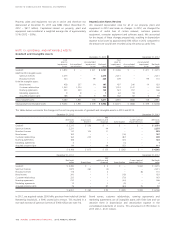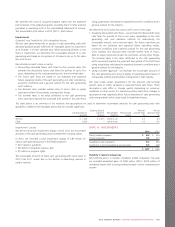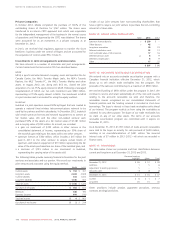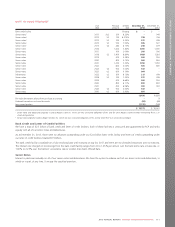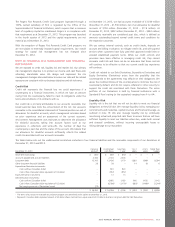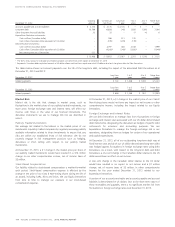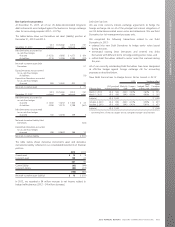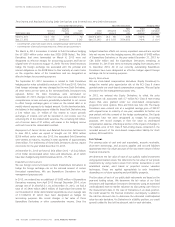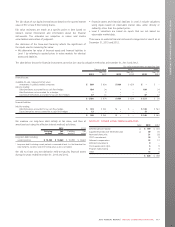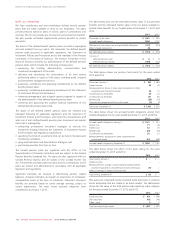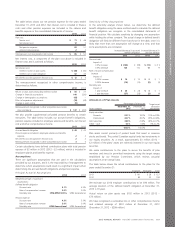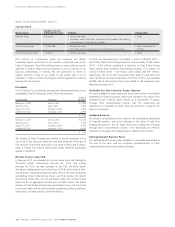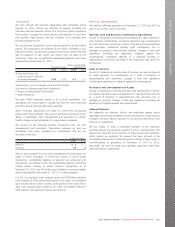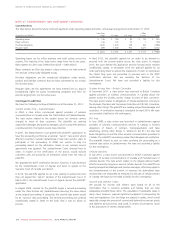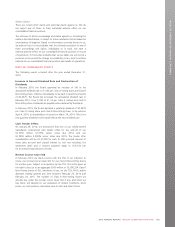Rogers 2013 Annual Report Download - page 120
Download and view the complete annual report
Please find page 120 of the 2013 Rogers annual report below. You can navigate through the pages in the report by either clicking on the pages listed below, or by using the keyword search tool below to find specific information within the annual report.
NOTES TO CONSOLIDATED FINANCIAL STATEMENTS
Terminated and Replaced Existing Debt Derivatives and Entered into New Debt Derivatives
Terminated Debt Derivatives New Debt Derivatives Hedging effect
Termination date
Notional
amount
Original
maturity
date
Cash
settlement
Date
entered
Derivative
amount
New
maturity
date
Fixed
weighted
average 1
Fixed
Canadian
equivalent 2
March 6, 2013 US $ 350 2018 Nil March 6, 2013 US $ 350 2038 7.62% $ 359
Sept. 27, 2013 US $ 1,075 2014-2015 $ 263 Sept. 27, 2013 US $ 1,075 2014-2015 7.42% $ 1,110
1Converting from a fixed US$ coupon rate to a weighted average Cdn$ fixed rate.
2Converting from a fixed US$ principal amount to a fixed Cdn$ principal amount.
The March 6, 2013 termination is related to Debt Derivatives hedging
the US $350 million senior notes due 2038 (2038 Notes). The Debt
Derivatives that were terminated on March 6, 2013 were not
designated as effective hedges for accounting purposes and had an
original term of 10 years to August 15, 2018. The new Debt Derivatives
hedge the foreign exchange risk associated with the principal and
interest obligations on the 2038 Notes to their maturity at market rates
on the respective dates of the transactions and are designated as
effective hedges for accounting purposes.
The September 27, 2013 termination is related to Debt Derivatives
hedging senior notes scheduled to mature in 2014 and 2015. Only the
fixed foreign exchange rate was changed for the new Debt Derivatives.
All other terms are the same as the terminated Debt Derivatives they
replaced. Before the Debt Derivatives were terminated on
September 27, 2013, changes in their fair value were recorded in other
comprehensive income and were periodically reclassified to net income
to offset foreign exchange gains or losses on the related debt or to
modify interest expense to its hedged amount. On the termination date,
the balance in the hedging reserve related to these Debt Derivatives was
a $10 million loss. $1 million of this related to future periodic
exchanges of interest and will be recorded in net income over the
remaining life of the related debt securities. The remaining $8 million,
net of income taxes of $1 million, will remain in the hedging reserve
until such time as the related debt is settled.
Repayment of Senior Notes and Related Derivative Settlements
In June 2013, when we repaid or bought our US $350 million
($356 million) senior notes due 2013, the associated Debt Derivatives
were settled at maturity, resulting in total payments of approximately
$104 million. The settlements of these Debt Derivatives did not impact
net income for the year ended December 31, 2013.
At December 31, 2013 we have US $6.4 billion (2012 – US $4.2 billion)
of US Dollar denominated senior notes and debentures, all of which
have been hedged using Debt Derivatives (2012 – 91.7%).
Expenditure Derivatives
We use foreign currency forward contracts (Expenditure Derivatives) to
hedge the foreign exchange risk on the notional amount of certain
forecasted expenditures. We use Expenditure Derivatives for risk-
management purposes only.
In 2013, we entered into an additional US $955 million of Expenditure
Derivatives maturing from April 2013 through December 2014, at an
average rate of $1.0341/US $1. As at December 31, 2013, we had a
total of US $900 million ($923 million) of Expenditure Derivatives for
our forecasted US dollar denominated expenditures at an average rate
of $1.0262/US $1 which have been designated as hedges for
accounting purposes. We record changes in fair value of these
Expenditure Derivatives in other comprehensive income. Once the
hedged transaction affects net income, equivalent amounts are recycled
into net income from the hedging reserve. We settled US $435 million
of Expenditure Derivatives in the year ended December 31, 2013 for
Cdn $430 million and the Expenditure Derivatives remaining at
December 31, 2013 have terms to maturity ranging from January 2014
to December 2014. All of our currently outstanding Expenditure
Derivatives have been designated as effective hedges against foreign
exchange risk for accounting purposes.
Equity Derivatives
We use stock-based compensation derivatives (Equity Derivatives) to
hedge the market price appreciation risk of the RCI Class B shares
granted under our stock-based compensation programs. We use Equity
Derivatives for risk-management purposes only.
In 2013, we entered into Equity Derivatives to offset the price
appreciation risk associated with 5.7 million RCI Class B Non-Voting
shares that were granted under our stock-based compensation
programs for stock options, RSUs and DSUs (see note 24). The Equity
Derivatives were entered into at a weighted average price of $50.37
with original terms to maturity of one year, extendible for further one
year periods with the consent of the hedge counterparties. The Equity
Derivatives have not been designated as hedges for accounting
purposes. We record changes in their fair value as stock-based
compensation expense, offsetting a portion of the impact of changes in
the market price of RCI Class B Non-Voting shares contained in the
recorded amount of the stock-based compensation liability for stock
options, RSUs and DSUs.
Fair Values
The carrying value of cash and cash equivalents, accounts receivable,
short-term borrowings, and accounts payable and accrued liabilities
approximate their fair values because of the short-term nature of these
financial instruments.
We determine the fair value of each of our publicly traded investments
using quoted market values. We determine the fair value of our private
investments by using market values from similar transactions or well
established market, asset based or projected income valuation
techniques. These are applied appropriately to each investment
depending on its future operating and profitability prospects.
The fair values of each of our public debt instruments are based on the
year-end trading values. We determine the fair values of our Debt
Derivatives and Expenditure Derivatives (Derivatives) using an estimated
credit-adjusted mark-to-market valuation by discounting cash flows to
the measurement date. In the case of Derivatives in an asset position,
the credit spread for the financial institution counterparty is added to
the risk-free discount rate to determine the estimated credit-adjusted
value for each derivative. For Derivatives in a liability position, our credit
spread is added to the risk-free discount rate for each derivative.
116 ROGERS COMMUNICATIONS INC. 2013 ANNUAL REPORT




